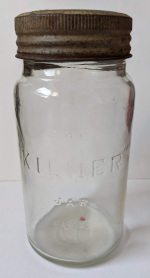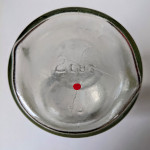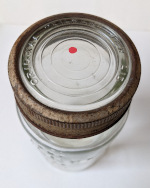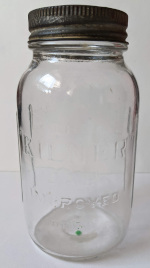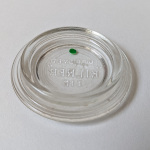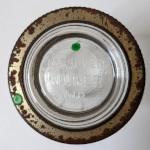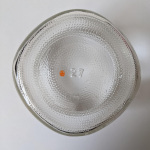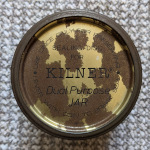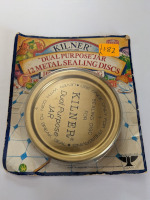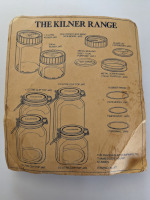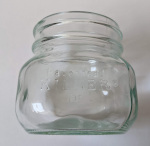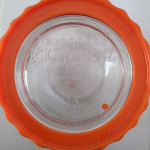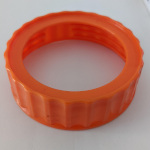Vintage
Kilner
Jars.
About this website
Use the timeline to identify your vintage Kilner® preserving jars and to help acquire missing parts to keep them in use.
Click on a timeline item for details, illustrations and images of the jar.
The history of the Kilner® Jar
The Original "Kilner" Jar
The first widely-available Kilner jars. These are cylindrical glass jars with glass lids. The jars are secured using a steel screw cap.
These jars were made using green glass between 1918 and 1932. The green jars often contain bubbles and other defects. From 1932 until 1948 they were manufactured using clear glass and are of a much higher quality.
Labels
The labelling of Original jars varies with their age. All Original Kilner jars are embossed with the kilner jar.
Older, green glass jars may be embossed with additional text. One example shows makers kilner brothers ltd cornisboro, dewsbury and london.
Sizes
The jars are usually embossed with their size, on the underside.
Original jars came in the following sizes:
| Size | Height | Diameter (base) |
|---|---|---|
| 1 Lb | 5 1⁄4" | 3 1⁄4" |
| 2 Lbs | 7" | 3 5⁄8" |
| 3 Lbs | 8" | 3 7⁄8" |
| 4 Lbs | - | - |
| 7 Lbs | - | - |
Lids
The lids are usually embossed with original "kilner" jar lid. They are all decorated with concentric circles. The lids fit over the neck of the jar and sit on a small lip or shoulder.
As with the jars, older, green-glass jars may be embossed with different text. Some jars are embossed with kilner bros makers.
Screw Caps
The steel screw caps, also known as bands, tarnish quite easily and are usually rusted. They can be used, with caution, as the metal does not contact food inside the jar.
The dimensions of the screw cap are shown on the following illustration:
Seals
The jars came with circular rubber seals, usually white in colour.
| Diameter (outer) | Diameter (inner) | Thickness |
|---|---|---|
| 2 7⁄8" | 2 9⁄16" | 3⁄32" |
| 74mm | 66mm | 2mm |
Gallery
Click an image of the jar to enlarge it.
The Improved "Kilner" Jar
An updated design, these are cylindrical glass jars with embossed vertical ridges for extra grip. The neck was also narrowed and shortened.
The jars have with glass lids and are secured using a steel screw cap.
Labels
The jars are embossed with the kilner jar improved regd.
Lids
The lids are embossed with improved "kilner" lid. They are not decorated. The lids fit inside the neck of the jar.
g = 1⁄4"
Sizes
Improved jars came in the following sizes:
| Size | Height | Diameter (base)* |
|---|---|---|
| 1 Lb | 5 1⁄4" | 3 1⁄8" |
| 2 Lbs | 6 29⁄32" | 3 11⁄16" |
| 3 Lbs | 7 5⁄8" | 3 29⁄32" |
* The diameter does not include the vertical ridges on these jars.
Screw Caps
As with the Original jars, the steel screw caps tarnish quite easily and are usually rusted. They can be used, with caution, as the metal does not contact food inside the jar.
The dimensions of the screw cap are shown on the following illustration:
Seals
The jars came with circular rubber seals, usually white in colour.
| Diameter (outer) | Diameter (inner) | Thickness |
|---|---|---|
| 2 1⁄2" | 2 1⁄4" | - |
| 64mm | 56mm | - |
Gallery
Click an image of the jar to enlarge it.
The Dual Purpose Jar
The Dual Purpose jars are squarish in shape, with rounded corners. They were the first Kilner jar to use a metal lid, made of steel. The metal lids are self-sealing. The underside is dimpled to increase the grip of the jar on a worktop.
Labels
The jars are embossed with kilner regd DualPurpose jar.
Lids
The lids are a thin sheet of steel known as a Sealing Disk. The disks are printed with kilner DualPurpose jar, along with instructions to use only once and to break the seal with a coin. The glass lids of the later Ravenhead jars also fit the Dual Purpose jars. However, the metal screw caps will not fit over a glass lid.
Some older Dual Purpose jars did come with glass lids and plastic screw bands, like the later Ravenhead jars. These jars have their capacity marked in ml and are not compatible with the steel lids and screw caps of later Dual Purpose jars.
The metal lids are 3 7⁄16" (84mm) in diameter and 0.5mm thick.
Sizes
Dual Purpose jars came in the following sizes:
| Size | Height | Diameter (base) |
|---|---|---|
| 1 Lb | - | - |
| 2 Lbs | - | - |
| 4 Lbs | - | - |
Screw caps
The metal screw caps were originally a golden, brass-like colour. This fades with time and use and most remaining caps are likely to be tarnished or slightly rusted.
The dimensions of the screw cap are shown on the following illustration:
Gallery
Click an image of the jar to enlarge it.
The Ravenhead "Red Top" Jar
From the late 1970's, Kilner jars were produced by Ravenhead Glassware. These jars are secured by a characteristic plastic screw cap, usually bright red or orange. This gave rise to the common name of "Red Top".
The jars are squarish, with rounded corners. They may have ridges or dimples on the underside to prevent them slipping off the worktop.
Labels
The jars are embossed with Ravenhead kilner Jar. Some jars are stamped with made in uk on underside.
Additional stamping on the underside may include a number and a letter. Examples include h 3, h 13 and p 1.
Lids
The lids are made of glass and are embossed with Ravenhead kilner and the Ravenhead Glass logo. They are not decorated. The lids fit inside the neck of the jar.
Oddly, the lids appear to use imperial measurements, despite the capacity of the jars using metric measurements. An illustration of the lid, with its dimensions, is shown below:
g = 7⁄16"
Sizes
Ravenhead jars came in the following sizes:
| Size | Height | Width (base) | Length (base) |
|---|---|---|---|
| 500ml | 95mm | 95mm | 95mm |
| 1000ml | 150mm | 95mm | 95mm |
| 1500ml | - | - | - |
Screw Caps
The chunky, plastic screw caps that secure Ravenhead jars are brightly coloured. They are usually red, although sometimes orange, white or brown. The caps are deeply ridged.
Seals
The jars came with circular rubber seals, usually red or orange in colour.
| Diameter (outer) | Diameter (inner) | Thickness |
|---|---|---|
| 3 1⁄4" | 2 9⁄16" | 2⁄32" |
| 82.5mm | 72mm | 1.8mm |
Gallery
Click an image of the jar to enlarge it.
The New Kilner Jar
Modern Kilner jars, also known as "New Kilner Jars", are available in screw top and clip-top variations. You can purchase these, as well as spares, from homeware stores or many online markets.
Please refer to the Kilner website for more information.
Resources
Disclaimer
The data, measurements and other information on this website is provided for free with absolutely no assurances that it is correct. I've done my best but please be sensible with it!
